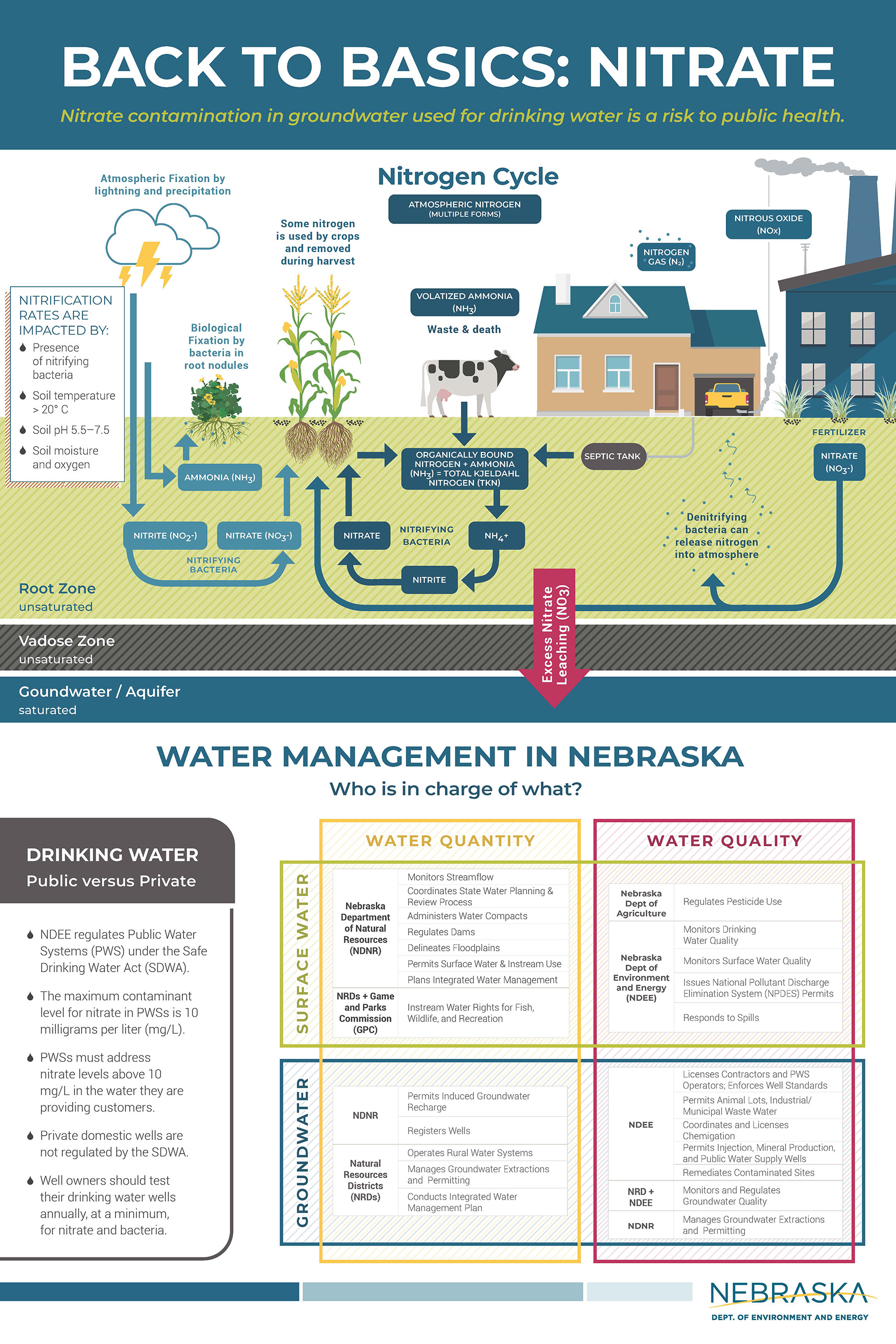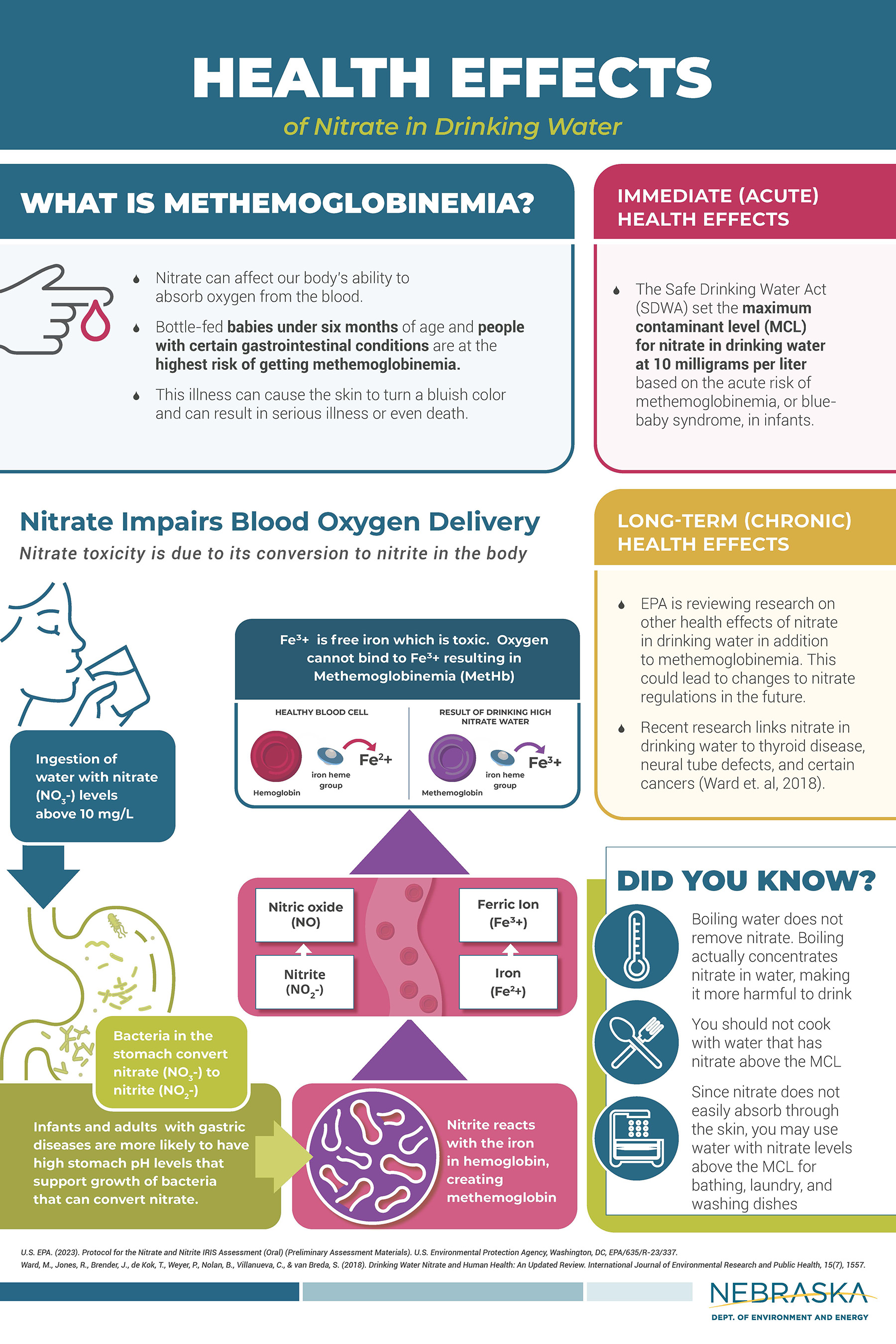What's in Your Water?
If a home’s water comes from a private well in Nebraska, it may have elevated levels of common nutrients found in agricultural fertilizers. Consuming water with elevated levels of nitrate can have significant health risks. Annual testing of your water is an important way to protect the health of everyone in your home.
The EPA guideline for safe drinking water is less than 10 parts per million (ppm) of nitrate. Municipalities are required by law to provide water that meets the EPA criteria, but for the many Nebraskans whose water comes from a private source, the quality of the water is the consumer’s responsibility.
Nitrate is a naturally occurring compound found in soil and water. However, consumption of high concentrations of nitrates has been linked to various adverse health outcomes. Certain human activities can contribute to concentrations of nitrate beyond the level considered safe. Unlike community water systems, private wells owned by individual households (of which about 20 percent of the state rely on for drinking water) do not require contaminant testing or treatment and are most at risk.
For private well owners, it’s important to test drinking water annually, as results can change from year to year.
The NRD offers free water testing to determine if a well is providing safe drinking water. Anyone in the district can request a simple at-home test by contacting the office at info@upperbigblue.org or (402) 362-6601. The at-home tests provide fast results but are not as sensitive and accurate as a lab test. For the best results, a sample should be brought to the office for free lab analysis. Instructions for how to collect a sample to bring in for analysis are at upperbigblue.org/water-testing.
If a lab test reveals that the water sample is above 10 ppm, funding is available for the homeowner through the NRD for the installation of a point-of-use reverse osmosis system. A properly installed and regularly maintained reverse osmosis system can reduce the amount of nitrates in water.
Nitrates and Human Health
Numerous scientific studies have looked at the relationship of nitrate in drinking water on human health and linked high concentrations of nitrate in drinking water to adverse health outcomes. The strongest links are for methemoglobinemia (“Blue Baby Syndrome”), colorectal cancer, thyroid disease, and neural tube defects (birth defects of spine, brain, and spinal cord). Agrochemicals in drinking water are also linked to increased heart rate, nausea, headaches, and abdominal cramps; cancers including pediatric brain cancer, kidney cancer, bladder cancer, and non-Hodgkin’s lymphoma. Other studies are also examining a possible link between these contaminants and Alzheimer’s, diabetes, and Parkinson’s disease.
Nebraska has one of the highest rates of some pediatric cancers, which may be linked to agrochemicals in drinking water. When it comes to health concerns and drinking water quality in Nebraska, the most vulnerable populations are young infants (less than six months old), pregnant women and children in-utero, and people with oxygen transport or delivery conditions like anemia, cardiovascular disease, lung disease, and sepsis.
NDEE Report
The Nebraska Department of Environment and Energy (NDEE) has released a report following the completion of the recent Nebraska Nitrate in Drinking Water Study.
Funding for the study came from the passage of LB 814 during the 2023 legislative session, at the request of Gov. Jim Pillen. The goal of this study was to provide an analysis and recommend viable solutions for nitrate-affected drinking water, including private domestic wells, which are not regulated by the Safe Drinking Water Act (SDWA). This study focuses on nitrate in groundwater being used for drinking water.
In addition to the final report, NDEE has developed tools and resources related to the study, including:
- A Geographic Information System (GIS) predictive nitrate groundwater concentration model
- An interactive, web-based GIS tool for NDEE and resource partners to assess nitrate risk for private domestic wells
- A nitrate outreach toolbox and guidance documents
- Additional private domestic well nitrate data from the 2023-2024 free sampling effort
- A public water system assistance ranking system to target outreach and funding
- Nitrate summary reports available to community water systems to show trends in their source water
The key resources and outputs from the study, including the final report, are provided on this page.
If you have a private domestic well and want to test your well for nitrate and/or bacteria, request a kit from the Department of Health and Human Services’ Public Health Environmental Lab. Nitrate sample kits cost $16, and coliform bacteria sample kits cost up to $17.
The study includes nitrate sampling data from public water systems, the Nebraska Groundwater Clearinghouse, and from private domestic well owners who agreed to participate in the agency’s free sampling effort that began in November 2023 and ended March 1, 2024. Nearly 3,500 test kits were returned for analysis and inclusion in the study, making this the largest private domestic well nitrate sampling effort in state history. NDEE is working to get the 2023-2024 Free Nitrate Sampling data uploaded to the Nebraska Groundwater Clearinghouse.



